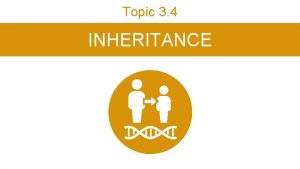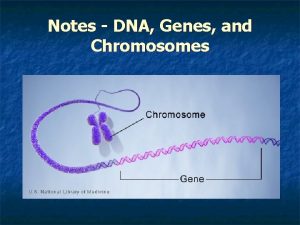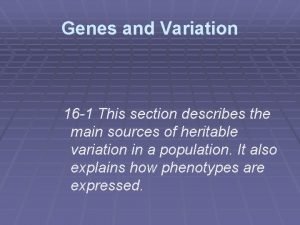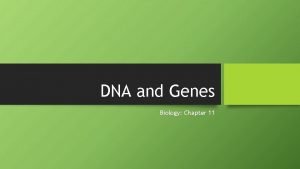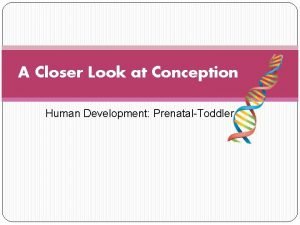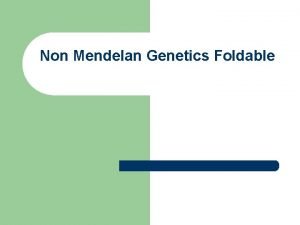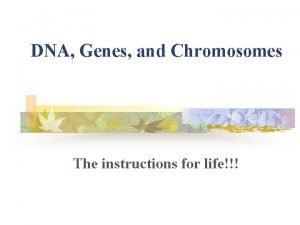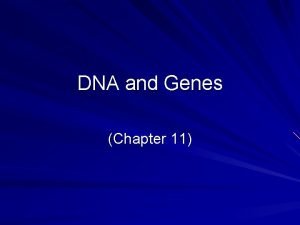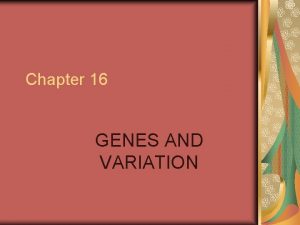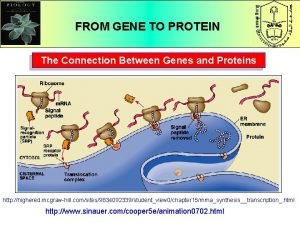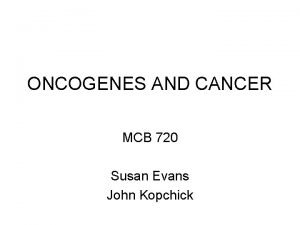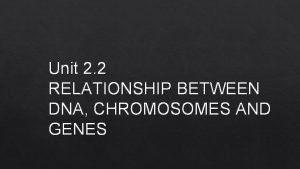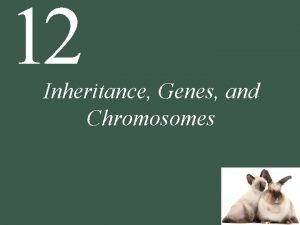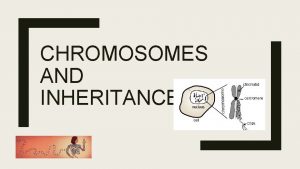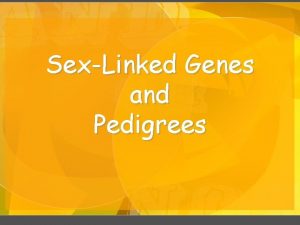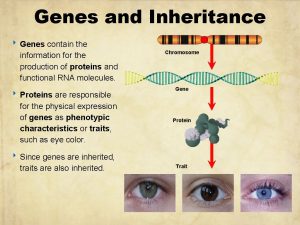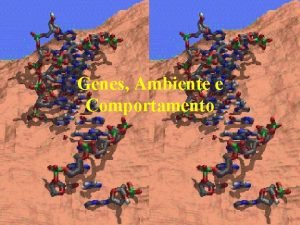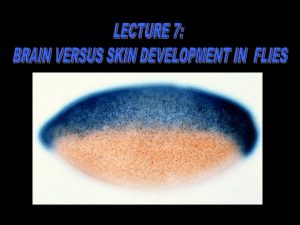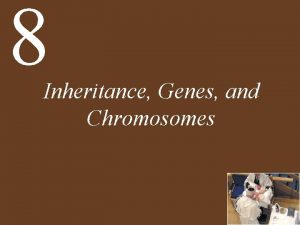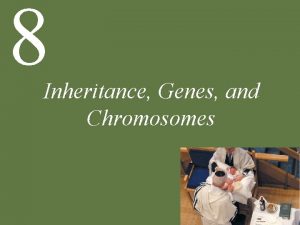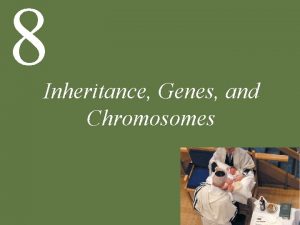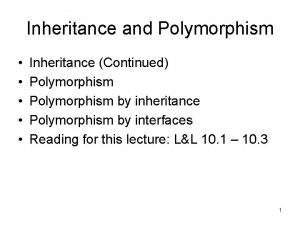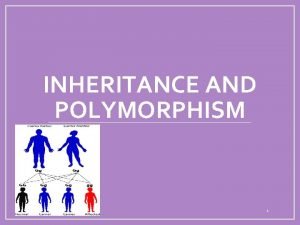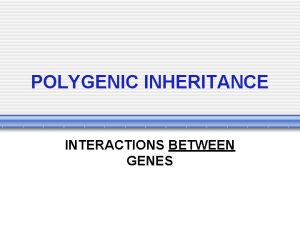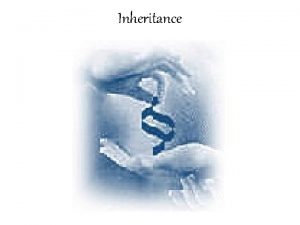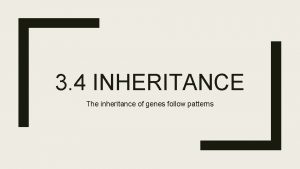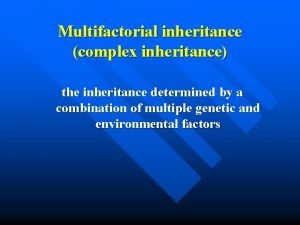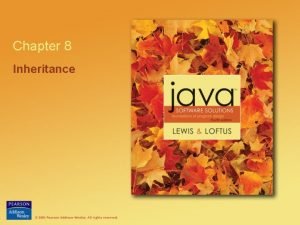The study of genes and the inheritance of



















- Slides: 19

The study of genes and the inheritance of traits GENETICS

CHROMOSOME STRUCTURE Replicated chromosome Chromatin: a complex of DNA and protein Cell Individual atoms Histone proteins DNA molecule (double helix comprising genes)

CHROMOSOMES Genes are part of chromosomes, which are long strands of a chemical substance called deoxyribonucleic acid (DNA). So genes are made up of DNA. Humans have 46 paired chromosomes (2 pairs of 23), with an estimated 20, 000 or so genes that are ‘beaded’ along these tightly bundled strands. As chromosomes come in pairs, there are two copies of each gene in the cell.

GENE CONTROL OF CHARACTERISTICS All characteristics are controlled by a minimum of 2 genes. These genes give the characteristic that may show through. Different genes that control the same feature are called ALLELES

ALLELES An Allele is an alternative form of a gene (one member of a pair) that is located at a specific position on a specific chromosome.

ALLELES Organisms have two alleles for each trait. When the alleles of a pair are heterozygous, one is dominant and the other is recessive. The dominant allele is expressed and the recessive allele is masked.

DOMINANCE AND RECESSIVE Some alleles for a feature able to mask the influence of other gene when they are paired The WINNING gene is DOMINANT and is represented by a capital letter e. g. H The masked gene is RECESSIVE shown as lower case of the same letter e. g. h

ALLELES T – is considered a dominant allele TT – is dominant t – is considered a recessive allele Tt – is dominant tt - is recessive

PHENOTYPE They are the traits determined by reading the genotype. Example : FF = black fur Black fur is the phenotype or trait

PUNNETT SQUARE Uses parental genotypes to determine the possible traits of their offspring. 4 offspring

SELECTED HEREDITARY TRAITS Dominant Recessive Right handedness Left handedness Hair on middle Segment of digits no hair Hitch-hiker’s thumb Normal thumb Polydactylism (extra digits) Normal digits Brachydactylism (short digits) Normal digits Pattern baldness Normal hair Free ear lobes Attached ear lobes Hitch-hiker’s thumb Free ear lobe Polydactylism is a dominant trait; a normal number of digits is the recessive condition. Attached ear lobe Mid-digit hair Handedness In this crowd of men, almost all show some degree of pattern baldness, a dominant trait.

HUMAN HANDEDNESS The trait of left or right handedness is genetically determined. Right-handed people have the dominant allele. People that consider themselves ambidextrous can assume they have the dominant allele for this trait. Dominant Recessive Phenotype: Right-handed Phenotype: Left-handed Allele: R Allele: r

EYE COLOR Determination of eye color is complex, involving perhaps many genes. Any eye color other than pure blue is determined by a dominant allele that codes for the production of the pigment called melanin. Hazel, green, grey and brown eyes are dominant over blue. Dominant Recessive Phenotype: Brown, green, hazel, or grey Phenotype: Blue Allele: B Allele: b

HUMAN TONGUE ROLL The ability to roll the tongue into a U-shape when viewed from the front is controlled by a dominant allele. There are rare instances where a person can roll it in the opposite direction (to form an n-shape). Dominant Phenotype: Can roll tongue Allele: T Recessive Phenotype : Cannot roll tongue Allele: t

HUMAN MID-DIGIT HAIR Some people have a dominant allele that causes hair to grow on the middle segment of their fingers. It may not be present on all fingers, and in some cases may be very fine and hard to see. Dominant Recessive Phenotype: Hair on mid segment Phenotype: No hair on mid segment Allele: M Allele: m

THUMB HYPEREXTENSION There is a gene that controls the trait known as hitchhiker's thumb, which is technically termed distal hyperextensibility. People with the dominant phenotype are able to curve their thumb backwards without assistance, so that it forms an arc shape. Dominant Recessive Phenotype: Hitchhikers thumb Phenotype: Normal thumb Allele: H Allele: h

HUMAN EAR LOBE ATTACHMENT In people with only the recessive allele (homozygous recessive), ear lobes are attached to the side of the face. The presence of a dominant allele causes the ear lobe to hang freely. Dominant Recessive Phenotype: Lobes free Phenotype: Lobes attached Allele: F Allele: f

OTHER HEREDITARY TRAITS Brown eyes are dominant over blue Dark brown hair is dominant over other hair colors Dominant Recessive Curly hair Straight hair Dark brown hair All other colors Coarse body hair Fine body hair Syndactylism (webbed digits) Normal digits Normal skin pigmentation Albinism Brown eyes Blue or grey eyes Short or far-sightedness Normal vision Normal hearing Deafness Normal color vision Color blindness Broad lips Thin lips Large eyes Small eyes Roll tongue into U-shape No tongue roll A or B blood factor O blood factor

Your genetic characteristics (phenotype) *Circle the trait you have! Number of class mates with each trait (or phenotype). Create a tally. Eye colour B –brown b – blue Brown Blue Handness R – right hand r – left hand Right Left Tounge roll T – can roll t – cannot roll Cannot roll Mid digit hair M – Hair m – No Hair No Hair Thumb extension H – bent h – normal Hitchhikers Normal Ear Lobes F – free Free Attached *includes any other eye colour other than blue
 Linked genes and unlinked genes
Linked genes and unlinked genes Linked genes and unlinked genes
Linked genes and unlinked genes Factors of 15
Factors of 15 Genetics is the study of heredity and variation.
Genetics is the study of heredity and variation. Autosomal dominant vs autosomal recessive
Autosomal dominant vs autosomal recessive Stabilizing selection human birth weight
Stabilizing selection human birth weight Dna, genes and chromosomes relationship
Dna, genes and chromosomes relationship Learn genetics utah karyotype
Learn genetics utah karyotype Single-gene trait
Single-gene trait Chapter 11 dna and genes
Chapter 11 dna and genes Evolution of populations section 16-1 genes and variation
Evolution of populations section 16-1 genes and variation Chapter 16 evolution of populations
Chapter 16 evolution of populations Dominant and recessive genes
Dominant and recessive genes Chromosomes genes and basic genetics foldable answer key
Chromosomes genes and basic genetics foldable answer key Dna, genes and chromosomes relationship
Dna, genes and chromosomes relationship Dna and genes chapter 11
Dna and genes chapter 11 Section 16-1 genes and variation
Section 16-1 genes and variation What is the connection between genes and proteins
What is the connection between genes and proteins Difference between proto oncogene and oncogene
Difference between proto oncogene and oncogene What is the relationship between dna chromosomes and genes
What is the relationship between dna chromosomes and genes




